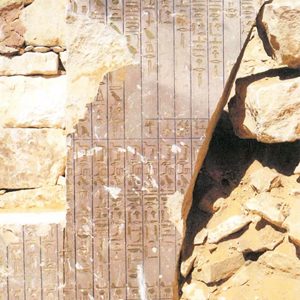 One of the pharaohs recorded on the Royal List of Abydos whose tomb is still unaccounted for is the mysterious Userkare. In our Heritage Key video The Hunt for the Lost Pharaoh:Userkare Dr Vasko Dobrev speculates on the possible location for the tomb of Userkare, a 6th Dynasty pharaoh who ruled shortly after Pharaoh Teti was assassinated by a priest.
One of the pharaohs recorded on the Royal List of Abydos whose tomb is still unaccounted for is the mysterious Userkare. In our Heritage Key video The Hunt for the Lost Pharaoh:Userkare Dr Vasko Dobrev speculates on the possible location for the tomb of Userkare, a 6th Dynasty pharaoh who ruled shortly after Pharaoh Teti was assassinated by a priest.
In this video, Dr Dobrev – Egyptologist and Archaeologist – shares that he believes Userkare to be buried at the Southern end of the Saqqara necropolis, where other 6th Dynasty kings can be found as well.
The plateau that Dr Dobrev is currently excavating at Tabbet al-Guesh for IFAO (Institut Franais dArchologie Orientale) measures 15 hectare, enough to contain an 80 x 80 metre pyramid, or a 60 x 60 metre temple (see map).
A pharaoh is never buried alone, and if Dr Dobrev is right, there should be a necropolis near to Userkare’s tomb. On this plateau, excavations of a fifth of a hectare in the north-west part of Tabbet al-Guech have already revealed 15 tombs from the 6th Dynasty.
As an example for his theory, Dr Dobrev points out the tomb of Haunufer, in which the walls read ‘beloved by the King’. The text – an ‘Appeal to the Living’, meant to be read by people bringing offerings – does not specify which king. Maybe this information was unnecessary, as the King – possibly Userkare – was buried nearby?
Now a second possible location for the Pyramid of Userkare has been found by Giulio Magli, a professor of archaeoastronomy at Milan’s Polytechnic University. He told Discovery News that a pattern of diagonal lines that connects the Egyptian pyramids might hold a clue to the location of Userkare’s tomb.
According to Magli’s theory, the pyramid – or a double-tomb complex – would be aligned with the Step Pyramid of Djoser, which was the most important pyramid at Saqqara. Giulio Magli’s research will be published in the next issue of Mediterranean Archaeology and Archaeometry.
According to Discovery News, Dr Dobrev agrees that Giulio Magli’s suggestion makes sense, if plotted out on a satellite map. In the field, it is more difficult to see.
Where do you think Pharaoh Userkare’s tomb will be found? . Oh, and just for those wondering, neither Dobrev nor Magli say the ancient Egyptians would have used GPScoordinates or required alien intervention to figure out the alignment!
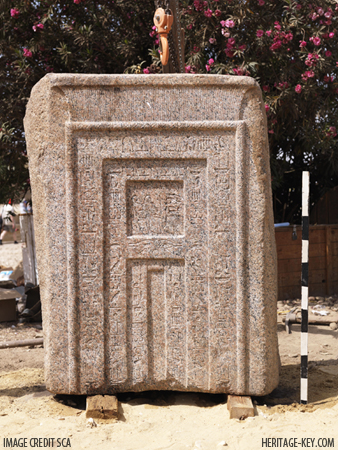 An Egyptian excavation team has made a new discovery at Karnak during routine excavation works. A large red granite false door belonging to the tomb of Queen Hatshepsuts vizier User and his wife Toy has been unearthed in front of
An Egyptian excavation team has made a new discovery at Karnak during routine excavation works. A large red granite false door belonging to the tomb of Queen Hatshepsuts vizier User and his wife Toy has been unearthed in front of 
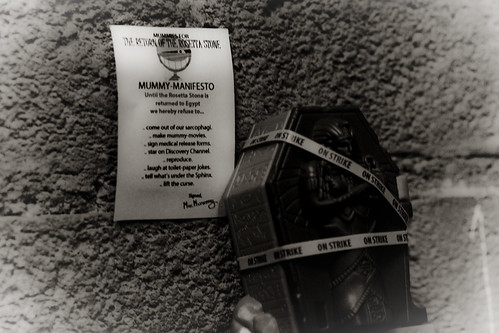
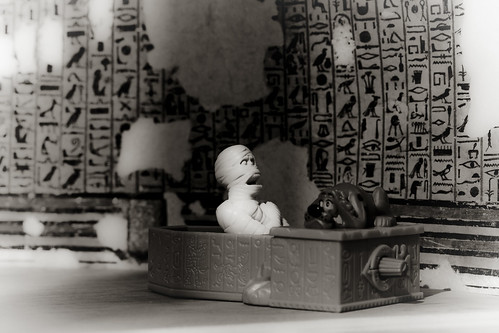
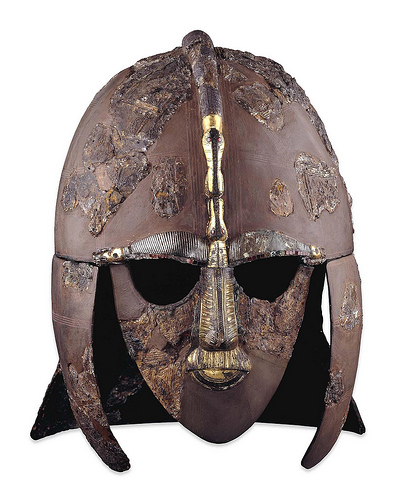 I believe I’ve found the ideal solution to ‘what music will we play in the office’. As we never seem to be able to reach agreement on the channel (really? Brit pop? Sounds from outer-space?), for tomorrow, I suggest we tune in on ‘Anglo-Saxon Aloud’, a website by Michael Drout that contains daily* readings of the entire Anglo-Saxon Poetic Records – which includes all poems written in Old English.
I believe I’ve found the ideal solution to ‘what music will we play in the office’. As we never seem to be able to reach agreement on the channel (really? Brit pop? Sounds from outer-space?), for tomorrow, I suggest we tune in on ‘Anglo-Saxon Aloud’, a website by Michael Drout that contains daily* readings of the entire Anglo-Saxon Poetic Records – which includes all poems written in Old English.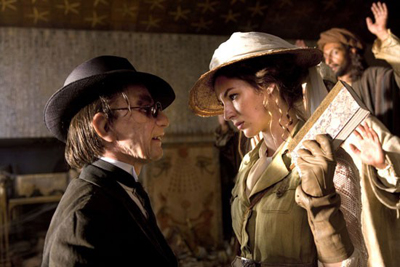 Good news for all fans of ‘light’ historical films such as The Mummy, Return of the Mummy and 10,000 BC. Even greater news for fans of the – sublime – comic (although BD, ‘bande dessine’ is more correct) series by Tardi. ‘Les Aventures Extraordinaires d’Adle Blanc-Sec‘ has been made into an adventure movie by Luc Besson (Taxi, Kamikaze, Leon, The Fifth Element), which will star lots of Mummies, at least one Pterodactyl and enough demon worshippers and mad scientists to keep the film going. Indiana Jones, beware emancipation! 😉
Good news for all fans of ‘light’ historical films such as The Mummy, Return of the Mummy and 10,000 BC. Even greater news for fans of the – sublime – comic (although BD, ‘bande dessine’ is more correct) series by Tardi. ‘Les Aventures Extraordinaires d’Adle Blanc-Sec‘ has been made into an adventure movie by Luc Besson (Taxi, Kamikaze, Leon, The Fifth Element), which will star lots of Mummies, at least one Pterodactyl and enough demon worshippers and mad scientists to keep the film going. Indiana Jones, beware emancipation! 😉 In these times, who would make an animated movie that was intentionally two-dimensional? Deflated and only minorly shaded, but visually ravishing. Flat, but filled with ancient swirls and Celtic knots. And who would have thought such a film would become a major hit? ‘The Secret of Kells’, a spirited retelling of the provenance of one of Irelands most cherished artefact, the Book of Kells, was a success in Irish, French and Belgian cinemas alike, got an Oscar nomination for Best Animated Feature Film and is now well on its way to conquering the United States of America. It is also the most fabulous animation film I’ve seen in ages
In these times, who would make an animated movie that was intentionally two-dimensional? Deflated and only minorly shaded, but visually ravishing. Flat, but filled with ancient swirls and Celtic knots. And who would have thought such a film would become a major hit? ‘The Secret of Kells’, a spirited retelling of the provenance of one of Irelands most cherished artefact, the Book of Kells, was a success in Irish, French and Belgian cinemas alike, got an Oscar nomination for Best Animated Feature Film and is now well on its way to conquering the United States of America. It is also the most fabulous animation film I’ve seen in ages In 1908, more than a decade before the discovery of Tutankhamun’s tomb, American retired lawyer and archaeologist Theodore Davis made a remarkable discovery. While excavating in the Valley of the Kings in Egypt, he unearthed about a dozen large storage jars. Their contents included broken pottery, bags of natron, bags of sawdust, floral collars, and pieces of linen with markings from years 6 and 8 during the reign of a then little-known pharaoh named Tutankhamun. The significance of the find was not immediately understood, and the objects entered the collection of The Metropolitan Museum of Art as a mystery. It was only several years later, after further excavations and study, that the Museums Herbert E. Winlock was able to identify them: the small cache contained the remains from the embalming and funeral of King Tut. These objects now get their own exhibition – Tutankhamun’s Funeral – which runs at New York’s Met until November 6th.
In 1908, more than a decade before the discovery of Tutankhamun’s tomb, American retired lawyer and archaeologist Theodore Davis made a remarkable discovery. While excavating in the Valley of the Kings in Egypt, he unearthed about a dozen large storage jars. Their contents included broken pottery, bags of natron, bags of sawdust, floral collars, and pieces of linen with markings from years 6 and 8 during the reign of a then little-known pharaoh named Tutankhamun. The significance of the find was not immediately understood, and the objects entered the collection of The Metropolitan Museum of Art as a mystery. It was only several years later, after further excavations and study, that the Museums Herbert E. Winlock was able to identify them: the small cache contained the remains from the embalming and funeral of King Tut. These objects now get their own exhibition – Tutankhamun’s Funeral – which runs at New York’s Met until November 6th.
 “Young man, well connected, in possesion of fig leave and spare rib is looking for young lady with an apple and a hunger for knowledge to get humanity started. Pets no objection.” Which famous person from (biblical) history just placed a personal on Heritage Key? No doubt you’ll recognize the aspiring lover in the winning entry for our
“Young man, well connected, in possesion of fig leave and spare rib is looking for young lady with an apple and a hunger for knowledge to get humanity started. Pets no objection.” Which famous person from (biblical) history just placed a personal on Heritage Key? No doubt you’ll recognize the aspiring lover in the winning entry for our 